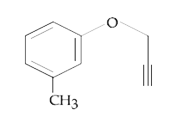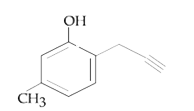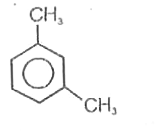What will be the major product when m-cresol is reacted with propargyl bromide (HC≡C−CH2Br) in Presence of K2CO3 in acetone?




The correct Answer is:B
To determine the major product when m-cresol reacts with propargyl bromide in the presence of K2CO3 in acetone, we can follow these steps:
1. Identify the Reactants:
- m-Cresol (also known as 3-methylphenol) has the structure:
C6H4(OH)(CH3)
- Propargyl bromide has the structure:
HC≡C−CH2Br
2. Understand the Reaction Conditions:
- K2CO3 acts as a base in this reaction.
- Acetone is used as a solvent.
3. Mechanism of the Reaction:
- The reaction follows the Williamson ether synthesis mechanism, which involves the formation of an alkoxide ion from m-cresol.
- K2CO3 will deprotonate the hydroxyl group (-OH) of m-cresol to form the alkoxide ion:
C6H4(O−)(CH3)+K+
4. Nucleophilic Attack:
- The alkoxide ion acts as a nucleophile and attacks the electrophilic carbon in propargyl bromide. The carbon attached to the bromine is a good electrophile due to the presence of the leaving group (Br).
- The reaction occurs via an SN2 mechanism, where the nucleophile attacks from the backside, leading to the displacement of the bromine atom.
5. Formation of the Ether:
- The product formed from this reaction will be an ether. The structure of the ether can be represented as:
C6H4(O)(CH3)−CH2−C≡C−H
- Therefore, the major product is:
C6H4(O)(CH3)−CH2−C≡C
Final Product:
The major product of the reaction is:
3-Methylphenyl propargyl ether
- m-Cresol (also known as 3-methylphenol) has the structure:
C6H4(OH)(CH3)
- Propargyl bromide has the structure:
HC≡C−CH2Br
- K2CO3 acts as a base in this reaction.
- Acetone is used as a solvent.
- The reaction follows the Williamson ether synthesis mechanism, which involves the formation of an alkoxide ion from m-cresol.
- K2CO3 will deprotonate the hydroxyl group (-OH) of m-cresol to form the alkoxide ion:
C6H4(O−)(CH3)+K+
- The alkoxide ion acts as a nucleophile and attacks the electrophilic carbon in propargyl bromide. The carbon attached to the bromine is a good electrophile due to the presence of the leaving group (Br).
- The reaction occurs via an SN2 mechanism, where the nucleophile attacks from the backside, leading to the displacement of the bromine atom.
- The product formed from this reaction will be an ether. The structure of the ether can be represented as:
C6H4(O)(CH3)−CH2−C≡C−H
- Therefore, the major product is:
C6H4(O)(CH3)−CH2−C≡C
The major product of the reaction is:
3-Methylphenyl propargyl ether
Topper's Solved these Questions
Similar Questions
Knowledge Check
- Question 1 - Select One
What is the major product of the following reaction ?
H2C=CH−CH2−OHHBr−−−→excessProductACH3−Br∣CH−CH2−BrBH2C=CH−CH2−BrCCH3−Br∣CH−CH2−OHDCH3−OH∣CH−CH2−OH
What products are formed when the following compound is treated with Br2 in the presence of FeBr3
 View Solution
View SolutionWhat will be the major product obtained when isobutene under goes reaction with HBr?
CH3−C∣CH3=CH2+HBr→?View SolutionWhat products are formed when the following compounds are treated with Br2 in the presence of FeBr3 ?
 View Solution
View SolutionWhat is the product when C6H5CH2NH2 reacts with HNO3?
View SolutionWhat is the product when C6H5CH2NH2 reacts with HNO3?
View SolutionDistinction between pairs of compounds
Ethyl bromide (CH3CH2Br) and bromobenzene (C6H5Br)View SolutionDistinction between pairs of compounds
Ethyl bromide (CH3CH2Br) and bromobenzene (C6H5Br)View Solution

_E01_273_Q01.png)